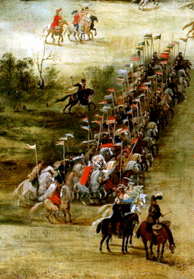 W
WThe Battle of Berestechko was fought between the Ukrainian Cossacks, led by Hetman Bohdan Khmelnytsky, aided by their Crimean Tatar allies, and a Polish army under King John II Casimir. It was a battle of a Cossack rebellion in Ukraine that took place in the years 1648–1657 after the expiration of a two-year truce. Fought from 28 to 30 June 1651, the battle took place in the province of Volhynia, on the hilly plain south of the Styr River. The Polish camp was on the river opposite Berestechko and faced south, towards the Cossack army about two kilometers away, whose right flank was against the River Pliashivka (Pliashova) and the Tatar army on their left flank. It is considered to have been among the largest European land battles of the 17th century.
 W
WThe Battle of Cecora took place on October 19–20, 1595, during an expedition of Jan Zamoyski, of the Polish-Lithuanian Commonwealth, to Moldavia, as part of the Moldavian Magnate Wars.
 W
WThe Battle of Cecora was a battle during the Polish–Ottoman War (1620–21) between the Polish–Lithuanian Commonwealth and Ottoman forces, fought from 17 September to 7 October 1620 in Moldavia, near the Prut River.
 W
WThe Battle of Chudnov took place from 14 October to 2 November 1660, between the forces of the Polish-Lithuanian Commonwealth, allied with the Crimean Tatars, and the Tsardom of Russia, allied with the Cossacks. It ended with a decisive Polish victory, and the truce of Chudnov. The entire Russian army, including its commander, was taken into jasyr slavery by the Tatars. The battle was the largest and most important Polish victory over the Russian forces until the battle of Warsaw in 1920.
 W
WThe Battle of Hodów was a battle between the Kingdom of Poland and Crimean Khanate forces, fought in June 1694 in the Ruthenian Voivodeship of the Crown of the Kingdom of Poland, near the village of Hodów. Often it is called the Polish Thermopylae, like the Battle of Wizna.
 W
WThe Battle of Khotyn or Battle of Chocim or Hotin War was a combined siege and series of battles which took place between 2 September and 9 October 1621 between a Polish-Lithuanian Commonwealth army together with their allied Cossack troops and an invading Ottoman Imperial army. The Commonwealth commanding officer, Grand Hetman of Lithuania Jan Karol Chodkiewicz, held the forces of Sultan Osman II at bay until the first autumn snows, dying in the process. On 9 October, due to the lateness of the season and heavy losses—from several assaults on fortified Commonwealth lines—the Ottomans abandoned their siege and the battle ended in stalemate, reflected in a treaty that in some sections favoured the Ottomans and in others favoured the Commonwealth. Chodkiewicz died on September 24, 1621 shortly after concluding a treaty with the Turks.
 W
WThe Battle of Kletsk was a battle fought on 5 August 1506 near Kletsk, between the army of the Grand Duchy of Lithuania, led by Court Marshal of Lithuania Michael Glinski, and the army of the Crimean Khanate, led by Fetih I Giray and Burnaş I Giray, sons of the Khan of Crimea, Meñli I Giray. The battle was one of the first and greatest Lithuanian victories over the Tatars.
 W
WThe Battle of Molodi was one of the key battles of Ivan the Terrible's reign. It was fought near the village of Molodi, 40 miles (64 km) south of Moscow, in July–August 1572 between the 40,000–60,000-strong horde of Devlet I Giray of Crimea and about 23,000–25,000 Russians led by Prince Mikhail Vorotynsky. The Crimeans had burned Moscow the previous year, but this time they were thoroughly defeated.
 W
WThe Battle of Petrovaradin took place on 5 August 1716 during the Austro-Turkish War, after the Ottoman army began to lay siege to the Habsburgs-controlled fortress of Petrovaradin on the Military Frontier of the Habsburg Monarchy. The Ottomans, prepared to capture Petrovaradin, the so-called Gibraltar on the Danube, experienced a heavy defeat by an army half the size of their own, similar to the defeat they had experienced in 1697 at Zenta. Ottoman Grand Vizier Damad Ali Pasha was fatally wounded, the Ottoman army lost 20,000 men and 250 guns to a Christian army, made mostly of veterans from the Flanders campaign, led by Field Marshal Prince Eugene of Savoy. The Austrians consolidated this victory by marching into the Banat and besieging Temesvár the last remaining Turkish fortress in Hungary followed by Belgrade.
 W
WThe Battle of Podhajce was fought in the town of Podhajce in the Polish-Lithuanian Commonwealth, and the area surrounding it as part of the Polish-Tartar War and the Great Turkish War. The army of the Polish-Lithuanian Commonwealth under John III Sobieski, totaling around 9,000 men defeated Tatar and Cossack forces under Petro Doroshenko and Adil Giray, which totaled around 35,000 men.
 W
WThe Battle of Wisniowiec took place on 28 April 1512.